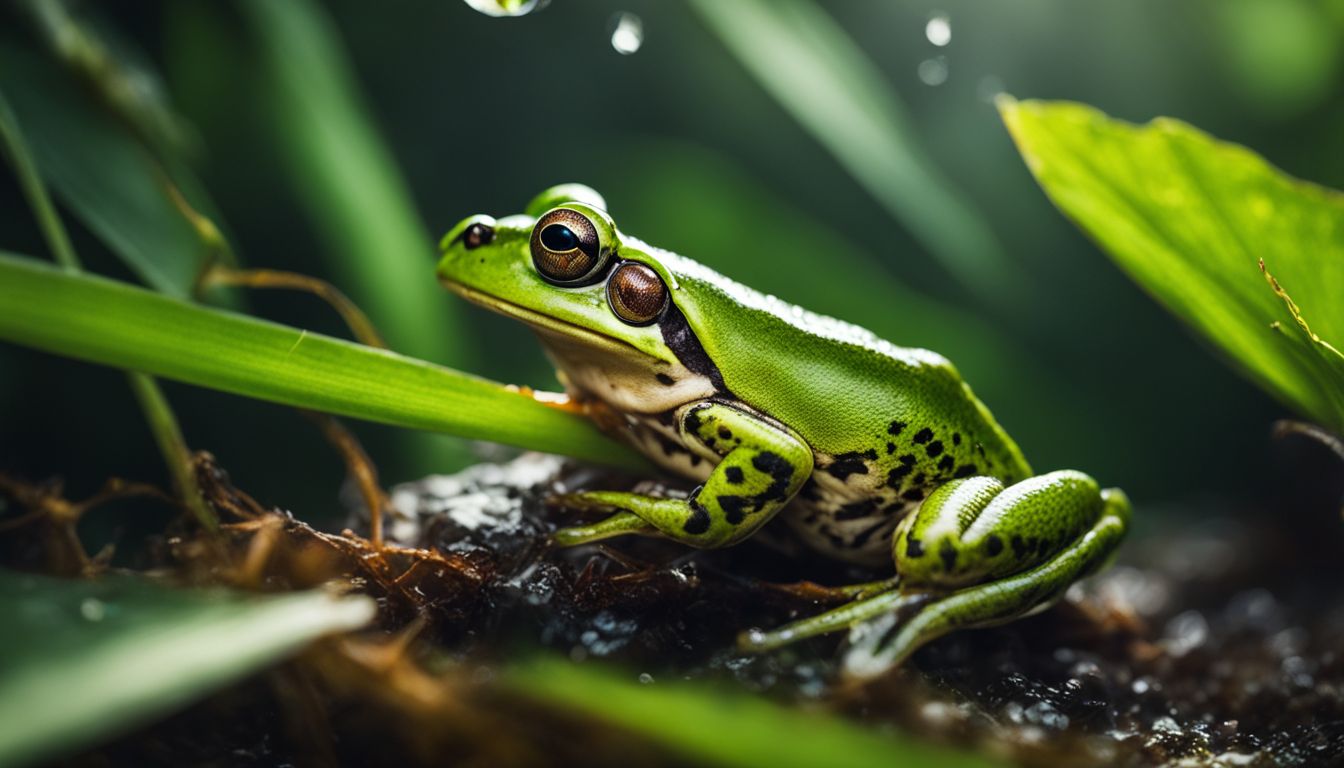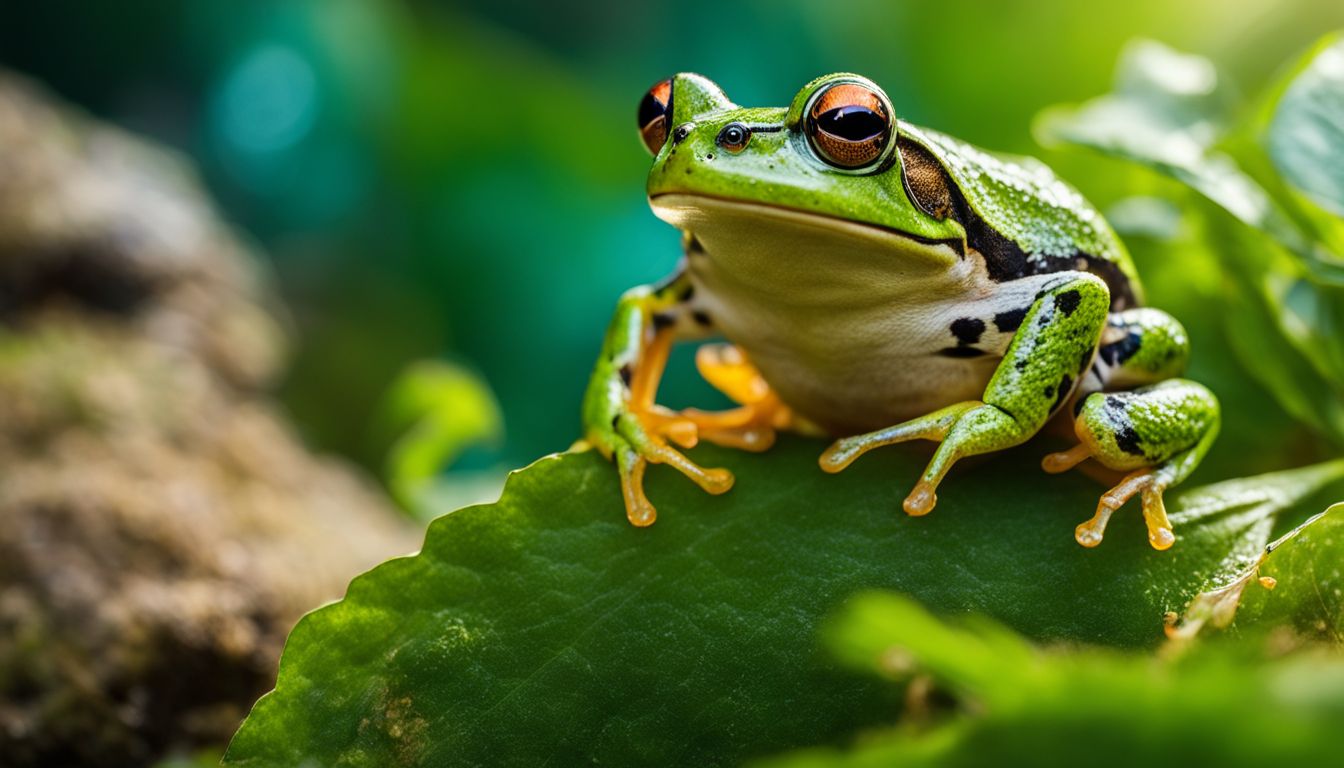Have you ever wondered what’s on the menu for our hoppy friends, frogs? It turns out that spiders can be a popular snack among these amphibians. In this article, we’ll dive into the world of frog diets and discover whether they really do feast on eight-legged critters.
Keep reading to find out about the fascinating feeding habits of frogs!
Key Takeaways
- Frogs are opportunistic eaters and will consume spiders as part of their varied diet, along with other prey like insects and small vertebrates.
- Their stomach acids neutralize the venom of spiders, making it safe for frogs to consume them without harm. They also immobilize and swiftly swallow the spider before it has a chance to bite them.
- Specific frog species such as the African Common Toad, White’s Tree Frog, and Pacman Frog have been observed consuming spiders as part of their natural diets, showcasing varied eating habits among different frog species.
Do Frogs Consume Spiders?

Frogs have a varied diet and are known to be opportunistic eaters, consuming a wide range of prey including spiders. Understanding their feeding habits and encounters with venomous spiders can provide insight into the safety of frogs consuming these insects.
The Diet Range of Frogs
Frogs love to munch on many kinds of bugs, not just flies and mosquitoes. They are carnivorous, which means they eat other animals for food. If a spider crawls by, a frog may snap it up with its sticky tongue.
These hopping creatures also go after bigger things like small mammals or even birds if they can catch them.
Their meals change depending on what’s around them. In places with lots of water, you might find frogs gobbling up fish or tadpoles. Forested areas could have them hunting beetles and worms under the leaves.
Frogs are really good at eating whatever they find in their homes, big or small!
Spiders as a Food Source
Spiders play a big role in the diets of some creatures, including frogs. Frogs often catch spiders with their sticky tongues. Spiders give frogs important nutrients and energy they need to live.
Frogs will eat many kinds of spiders, like wolf spiders, tarantulas, and even black widows.
In the wild, there’s a balance between eating and being eaten. While frogs hunt for spiders to snack on, other animals might be looking at those very same frogs as their next meal! This is how nature keeps everything in check.
Understanding Frog Feeding Habits

Frogs are opportunistic predators and will consume a wide variety of prey, including spiders. However, specific feeding habits can vary among different frog species.
Opportunistic Eating Behaviors
Frogs will eat almost anything that fits into their mouth if it’s moving and catches their eye. They don’t chase after one kind of meal. Instead, they grab what they can when the chance comes up.
This makes them opportunistic predators; they make the most of what is available in their environment. For example, leaf-litter frogs often go after spiders instead of tiny mites because spiders are just the right size for a snack.
Different frog species might show different eating habits based on where they live or how big they are. But as a whole group, frogs aren’t picky eaters at all. In fact, studies like those on the Leptodactylus fuscus frog have shown that male and female frogs often do not compete for food because each finds plenty to munch on due to being generalists—they take advantage of diverse foods whenever possible.
Variations Among Frog Species
Frogs come in different types, each with its own food preferences and hunting habits. Some frog species prefer to dine on insects like crickets, while others go for spiders or even small vertebrates.
The African Common Toad is known for consuming a variety of prey such as centipedes, scorpions, and spiders, including venomous ones in the wild. On the other hand, White’s Tree Frog typically feeds on insects and smaller frogs but may also indulge in an occasional spider snack.
Now let’s delve into some specific examples of frogs that have particular diets.
Examples of Frogs That Eat Spiders
Some frog species, like the African Common Toad, White’s Tree Frog, and Pacman Frog, have been known to consume spiders as part of their diet. These frogs are opportunistic feeders and may hunt for spiders in their natural habitats.
African Common Toad
African Common Toads are medium-sized frogs that often eat different types of insects, including spiders. These frogs also benefit from the fact that the remains of the spiders’ meals provide food for their tadpoles.
African Common Toads have a varied diet and play an essential role in controlling insect populations.
These toads actively hunt and consume various insects, keeping the ecosystem balanced. The consumption of spiders by African Common Toads helps regulate spider populations while providing nourishment for themselves and their offspring.
White’s Tree Frog
Moving on from the African Common Toad, let’s talk about White’s Tree Frog. This species of frog is known to have a diverse diet, including insects like moths, locusts, and roaches.
They also eat spiders and even smaller mammals and amphibians. In fact, the leftovers of spiders’ meals can provide food for the tadpoles of White’s Tree frog. These frogs are quite opportunistic in their eating habits, making them adaptable to various food sources in their environment.
White’s Tree Frog is a fascinating example of a frog that consumes a wide range of prey items including spiders as part of its natural diet. It showcases how different frog species can have varied eating habits based on their habitats and adaptability to available food sources.
Pacman Frog
Now, let’s turn our attention to the Pacman frog. These large frogs from Argentina are known for their varied diet, which includes spiders in addition to insects like moths, roaches, and ants.
When it comes to feeding on venomous spiders, the Pacman frog quickly immobilizes and swallows them before any harm can be done. As primarily carnivorous creatures, these frogs have an extensive list of favorite foods—ranging from insects to fruits and vegetables.
Pacman frogs can also be referred to as “Pacman’s,” showcasing how versatile their diet can be. Native to Argentina, they are mainly carnivores with a preference for insects but not limited to consuming fruits and vegetables along with other types of prey such as spiders.
Encounters with Venomous Spiders
Frogs may encounter venomous spiders in their natural habitats, but research indicates that they are able to safely consume them due to their unique digestive systems and resistance to certain toxins.
This section will discuss the safety of frogs eating venomous spiders and provide insight into specific encounters between frogs and dangerous spider species.
Frogs vs. Venomous Spiders
In the wild, frogs eat venomous spiders, like black widows and recluse spiders. Their stomach acids neutralize the spider venom so it doesn’t harm them. Research shows that while some spiders do eat frogs, predatory spiders have a greater impact on frog populations.
Spiders catching and eating frogs has been observed by researchers in various studies.
Frogs’ ability to consume venomous spiders without harmful effects is fascinating but not unique among amphibians. Other animals also demonstrate similar resilience when consuming toxic prey.
The Safety of Frogs Eating Venomous Spiders
Frogs usually do not face much danger when eating venomous spiders. Their stomach acids can neutralize the venom, making it harmless. Also, frogs tend to immobilize and swiftly swallow the spider before it has the chance to bite them.
However, some questions remain about whether frogs are immune to the venom of other creatures like scorpions and snakes.
As we move forward to “Are Sun Spiders Poisonous?”, let’s explore more about these fascinating interactions between frogs and their prey.
Are Sun Spiders Poisonous?
When it comes to sun spiders, also known as Wind Scorpions, it’s important to note that they are not poisonous creatures. Despite their name and appearance, sun spiders do not possess venom and are harmless to humans and animals.
Although they may look intimidating due to their spider-like features, sun spiders belong to a group of arachnids called solifuges, and they do not have a venomous bite like some spiders or scorpions.
Therefore, if you come across a sun spider in your environment, there is no need for concern about its potential toxicity.
Conclusion
In conclusion, frogs are known to consume spiders as part of their diverse diet. They will eat spiders that are meal-sized, regardless of the species. Frogs’ stomach acids generally neutralize the venom of spiders, making it safe for them to enjoy their eight-legged meals.
This behavior showcases the opportunistic feeding habits of these fascinating amphibians in a wide range of habitats and regions around the world.
If you’re curious about the relationship between frogs and potentially dangerous arachnids, find out more by reading “Are Sun Spiders Poisonous?“.
FAQs
1. Do frogs eat spiders?
Yes, some frogs do eat spiders along with other small creatures like insects and worms.
2. Can all types of frogs eat spiders?
Mostly, it’s the big frogs like bullfrogs that can easily catch and eat spiders. Smaller kinds, such as dart frogs from tropical regions, might too if the spider is tiny enough.
3. Are there any dangers for a frog when eating certain spiders?
Yes, some spiders can be harmful to frogs. The black widow spider has strong poison that could hurt or even kill a frog if bitten.
4. What else do frogs like to eat besides spiders?
Frogs also enjoy munching on things like flies, fleas, superworms, and sometimes even pinkie mice or small lizards.
5. Can pet store bought captive bred salamanders co-exist with wild-caught ones in a display tank?
It’s important not to mix wild-caught salamanders with those from pet stores because they might have different parasites or diseases that could spread between them.
6. Is it safe for people who keep pets at home to let their captive-bred pac man frog live among plants?
People should be careful when setting up their pet’s home; make sure your pets are safe and won’t get poisoned by plants or escape and become lost.




